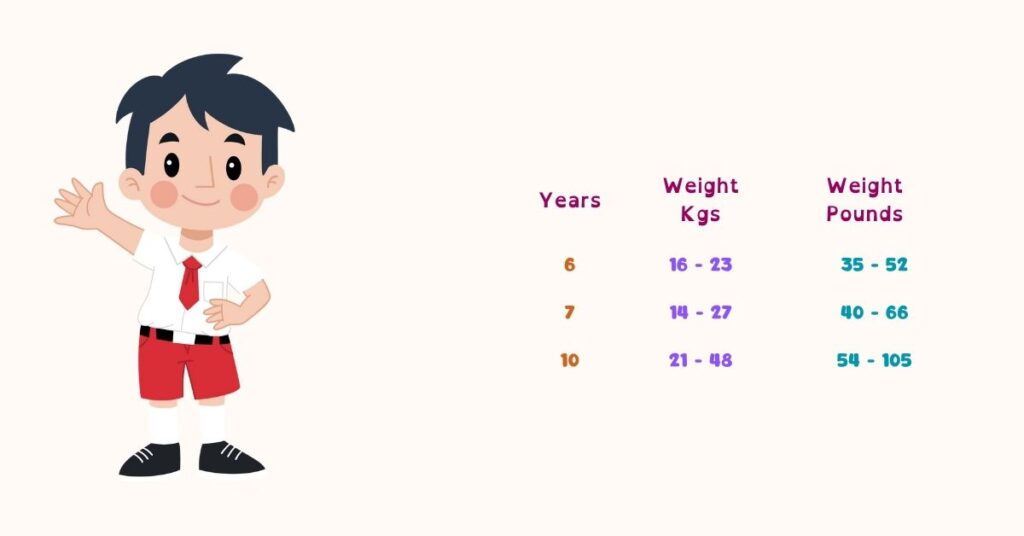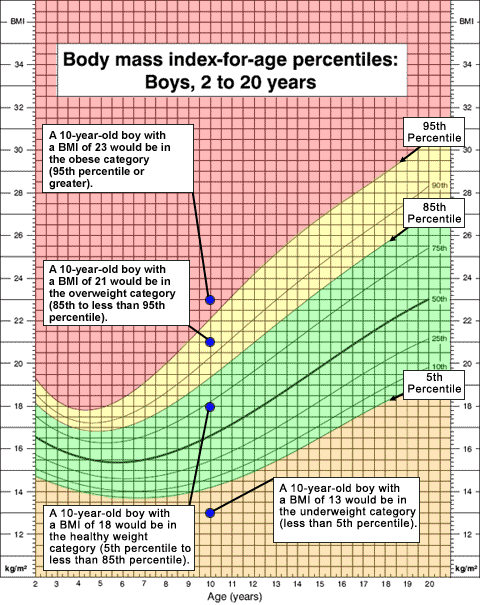Over the last decade, the health sector has upped the campaign about maintaining ideal weight for kids. Recent studies show that in the US, almost 19.7% of children ages 2-19 have obesity.
This means 19% of children are at an increased risk of getting diabetes, asthma, high blood pressure, and gallbladder disease, not to mention the psychological issues that come with being overweight.
And since overweight children grow up to become overweight adults, early child obesity prevention is critical.
So, how much should a child weigh at every age?
Are You Worried About Your Child’s Weight? Ideal Weight for Kids
The World Health Organization has a simple weight range for kids under 2 years, while the CDC provides one for kids older than 2. This particular chart shows weights in the 50th percentile, which is the average weight.
PS: For kids born prematurely, use adjusted age when looking up their weight according to age in kg on the chart below. (Adjusted weight is the age they would be if they were born full-term).
Weight Chart According to Age [for boys and girls in pounds]
| Age | Boys | Girls |
|---|---|---|
| Birth | 7 lb 8 oz (3.4 kg) | 7 lb 1 oz (3.2 kg) |
| 1 Month | 9 lb 15 oz (4.5 kg) | 9 lb 4 oz (4.2 kg) |
| 2 Months | 12 lb 6 oz (5.6 kg) | 11 lb 4 oz (5.1 kg) |
| 3 Months | 14 lb 2 oz (6.4 kg) | 13 lb (5.9 kg) |
| 4 Months | 15 lb 7 oz (7 kg) | 14 lb 2 oz (6.4 kg) |
| 5 Months | 16 lb 9 oz (7.5 kg) | 15 lb 3 oz (6.9 kg) |
| 6 Months | 17 lb 7 oz (7.9 kg) | 16 lb 2 oz (7.3 kg) |
| 7 Months | 18 lb 5 oz (8.3 kg) | 16 lb 12 oz (7.6 kg) |
| 8 Months | 18 lb 15 oz (8.6 kg) | 17 lb 10 oz (8 kg) |
| 9 Months | 19 lb 10 oz (8.9 kg) | 18 lb 1 oz (8.2 kg) |
| 10 Months | 20 lb 5 oz (9.2 kg) | 18 lb 12 oz (8.5 kg) |
| 11 Months | 20 lb 12 oz (9.4 kg) | 19 lb 3 oz (8.7 kg) |
| 12 Months | 21 lb 6 oz (9.7 kg) | 19 lb 14 oz (9 kg) |
| 18 Months | 24 lb (10.9kg) | 22 lb 8 oz (10.2 kg) |
| 24 Months | 28 lb (12.7 kg) | 26 lb 11 oz (12.1 kg) |
Average Height and Weight of kids Ages 1 to 18 years
Every child grows at their own pace, but having a general idea of what’s considered standard weight according to age is helpful. This chart shows the ideal height and weight for kids from 24 months till they are 18 years. It can be a helpful tool for tracking your child’s growth patterns. If you have any concerns, it’s best to ask your doctor.
| Age | Girls Height (Inches) | Girls Height (Pounds) | Boys Height (Inches) | Boys Height (Pounds) |
|---|---|---|---|---|
| 1 | 27 to 31 | 15 to 20 | 28 to 32 | 17 to 21 |
| 2 | 31.5 to 36 | 22 to 32 | 32 to 37 | 24 to 34 |
| 3 | 34.5 to 40 | 26 to 38 | 35.5 to 40.5 | 26 to 38 |
| 4 | 37 to 42.5 | 28 to 44 | 37.5 to 43 | 30 to 44 |
| 6 | 42 to 49 | 36 to 60 | 42 to 49 | 36 to 60 |
| 8 | 47 to 54 | 44 to 80 | 47 to 54 | 46 to 78 |
| 10 | 50 to 59 | 54 to 106 | 50.5 to 59 | 54 to 102 |
| 12 | 55 to 64 | 68 to 136 | 54 to 63.5 | 66 to 130 |
| 14 | 59 to 67.5 | 84 to 160 | 59 to 69.5 | 84 to 160 |
| 16 | 60 to 68 | 94 to 172 | 63 to 73 | 104 to 186 |
| 18 | 60 to 68.5 | 100 to 178 | 65 to 74 | 116 to 202 |
Weight According to Age in KG
On average, babies are born with 5 1/2 to 9 1/2 pounds, with most girls being a few ounces lighter than boys. Though infants lose about 10% of their weight during the first week after birth, they regain it in the second week.
Click to see weight according to age in kg [child weight by age] or use the helpful chart below.
1-year-old weight: Girls– 8-12 kg Boys– 8-12 kg
2-year-old weight: Girls– 10-14 kg Boys– 10-14 kg
3-year-old weight: Girls– 11.5-17kg Boys– 15.5-18kg
4-year-old weight: Girls– 14.5-17. kg Boys– 15-17.6 kg
5-year-old weight: Girls– 16-20 kg Boys– 16-21 kg
6-year-old weight: Girls– 18-23 kg Boys– 18-24 kg
7-year-old weight: Girls– 20-26 kg Boys– 20-27.5 kg
8-year-old weight: Girls– 22-28 kg Boys– 23-30 kg
9-year-old weight: Girls– 25-32 kg Boys– 26-34 kg
10-year-old weight: Girls– 28-36 kg Boys– 23-39.6 kg
11-year-old weight: Girls– 31-40 kg Boys– 33-43 kg
12-year-old weight: Girls– 34-45 kg Boys– 36-48 kg
13-year-old weight: Girls– 37-50 kg Boys– 40-54 kg
14-year-old weight: Girls– 40-55 kg Boys– 43-59 kg
15-year-old weight: Girls– 43-58 kg Boys– 47-63 kg
16-year-old weight: Girls– 45-60 kg Boys– 50-67 kg
17-year-old weight: Girls– 47-62 kg Boys– 53-70 kg
18-year-old weight: Girls– 49-64 kg Boys– 55-73 kg
As seen in the chart, babies gain about an ounce daily or a pound every month until they are 3 months old and double their birth weight by 4 months.
Kids also have growth spurts, so the weight gain is not always gradual. So don’t be surprised if they add a few ounces in one month and then climb the charts the following month.
If you use the metric system, we will give the ideal weight for kids in kg to make it easier for you.
Also read: Study Snacks for Kindergarten Students [3 Food Groups to Buy]
Toddler and Preschooler Ideal Weight
Between ages 1 and 5, a child gains 10 pounds. 5 pounds in the first year and the remaining 5 between ages 2 and 5.
So what’s the ideal weight for a 2 year old?
The normal weight of a 2-year-old in kg is between 10 and 14 kg or 22 and 33 pounds, and a 4-year-old is between 12 to 20 kgs or 28 and 44 pounds.

When they join preschool at age three, the change of environment triggers some stress and decreased appetite. This could lead to slower growth, which will pick up after a few months. Keep offering the child healthy food even if they are not gaining weight.
Elementary Kids Ideal Weight
What’s the average weight of a 6-year-old? According to the CDC growth chart, the average weight of a 6-year-old in kg should be between 16 and 23 kgs or 35 and 52 pounds. A 7-year-old should weigh between 14 and 27 kg or 40 and 66 pounds.

A 10-year-old should weigh anywhere between 24 and 48 kg or 54 and 105 pounds. Girls can weigh anywhere from 24 to 46kgs or 53 to 102 pounds. Unless there is a health issue, kids from age 2 should gain weight and grow steadily until they are pre-teens.
Kids’ ideal weight at this age is determined using BMI for age, or body mass index- a formula that uses weight and height to estimate how much body fat a child has.
Ideal Weight For Teenagers
Between ages 9 and 15, a child is likely to go through another growth spurt. Ideal weight for youngsters here will depend on their height, so body mass index for children is still the best weight tracking method.

So, how much should a 12 year old weigh? The CDC says that the average 12-year-old should weigh 30 to 58 kg or 66 to 130 pounds. A thirteen-year-old boy will weigh between 32 and 48 kg or 70 to 105 pounds. A fifteen-year-old roughly weighs around 40 to 76 kgs or 90 to 168 pounds.
Also read: 25+ Activities for Pre-Teenagers
What Experts Say: Pediatric Weight Standards
How do doctors and pediatricians determine kids’ ideal weight?
Infants below two years use the Personal Child Health Record booklet you are given after giving birth. The road-to-health booklet has a percentile growth chart that acts as a guide every time the child’s weight is taken.
A similar CDC children’s weight chart is used after age 2 to keep track of a child’s growth and weight. This chart shows a graph with the child’s age at the bottom and weight on the vertical axis. Inside the graph are multiple lines labeled percentiles.
Percentiles show how a child’s weight and height (or BMI) compare to other children of the same age and sex. Pediatricians translate the chart into 4 Kids’ weight development benchmarks:
- 4th percentile or lower is underweight
- 5th– 85th percentile is a healthy weight for kids. Most kids range in the 50th percentile.
- 85th-94th percentile is overweight
- 95th percentile or higher is dangerously obese.

Weight Concerns: When to Talk to Your Doctor
We know weight can be a concern for parents, but a healthy lifestyle is key. While weight charts are a helpful tool, it’s important to be aware of situations where a pediatrician’s guidance might be beneficial. Here are some signs that might indicate a need for a checkup:
- Rapid weight gain or loss: This can be a sign of underlying health issues and should be discussed with a pediatrician.
- Weight far outside the expected range for a child’s age and height: Pediatricians use growth charts to track a child’s weight and height relative to their age and sex. Significant deviations from these percentiles might warrant a checkup.
- Changes in eating or activity habits: If a child who normally eats well suddenly loses interest in food or becomes very withdrawn, or a previously active child becomes lethargic, these could be signs of a problem.
- Snoring or sleep apnea: Excess weight can contribute to blocked airways, leading to snoring or sleep apnea, which can affect a child’s sleep quality and overall health.
- Social or emotional difficulties: Weight concerns can sometimes lead to bullying or teasing, impacting a child’s self-esteem and mental health.
Track Your Child’s Weight
Keeping track of a child’s chart over a period of one or two years is crucial to determining their overall health. You cannot get the real picture from just looking at one weight reading. The doctor will examine the chart and see how the percentile lines go.
However, since a high BMI for the pediatric population is not a sign of good or poor health, he will also investigate other parts like cholesterol levels, physical activity, diet, and family history before making recommendations. This is because some children just have heavy bone density, which may make the BMI calculator inaccurate.
Also Read: Brain Development Food for Autistic Child [A Guide]
Body Mass Index for children differs from BMI for adults because it is interpreted relative to age, sex and other children the same age. Though the initial formula is the same, pediatric weight trends are interpreted according to percentiles from the CDC growth charts based on the national survey data.
Obesity is defined as a BMI for age above the 95th percentile. They are also overweight if their BMI is continuously in the 85th to 95th percentile. Between the 3rd and 91st centile is the ideal level at which they feel the most comfortable.
BMI for children is not an accurate measure of body fat. Children can have normal BMI and fall in the right percentile but still have too much body fat. It is even less accurate during puberty when kids have a growth surge and gain height or weight drastically.




